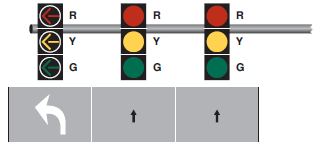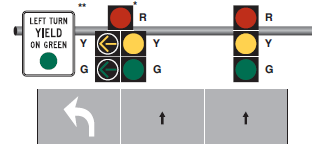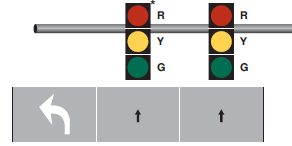Section 6: Flashing Yellow Arrow Display for Left-Turn Operations
Anchor: #PHCVQSFJPurpose
The purpose of this section is to provide guidance on the requirements for the design, use and operation of signalized left-turn operations resulting from the adoption of the 2011 Texas Manual on Uniform Traffic Control Devices (TMUTCD). These guidelines apply specifically to signalized left-turn operations and were first implemented on April 17, 2012.
Anchor: #i1040177Background
The 2011 TMUTCD contains several changes that affect the design and operation of traffic signals. These changes include the addition of a Flashing Yellow Arrow (FYA) display for permissive left-turn operations. While a 5-section signal face with a circular green may still be used in a shared left-turn signal face, the use of a circular green indication in a separate left-turn signal face for permissive left turns has been prohibited. The flashing yellow arrow (or flashing red arrow) is now the only allowable indication for a permissive left/right-turn in a separate left/right-turn signal face.
Information provided in this section is for guidance and comes from Part 4 of the TMUTCD.
Anchor: #i1039674Signal Face Types
Definitions of a Shared Left-Turn Signal Face and a Separate Left-Turn Signal Face as outlined in the TMUTCD are presented below.
- Anchor: #KXCYFAPD
- Shared Left-Turn Signal Face: A signal face that controls both a turn movement and the adjacent through movement and always displays the same color of circular signal indication that the adjacent through signal face or faces display. Anchor: #AQRXRYBK
- Separate Turn Signal Face: A signal face that exclusively controls a turn movement and that displays signal indications that are applicable only to the turn movement.
Modes of Operation
Left-turning traffic is controlled by one of four modes as follows: protected only, protected permissive, permissive only, or variable by time of day.
- Anchor: #AKOMMOMY
- Permissive-Only Mode. Turns are allowed on a CIRCULAR GREEN signal indication, a flashing left-turn YELLOW ARROW signal indication, or a flashing left-turn RED ARROW signal indication after yielding to pedestrians, if any, and/or opposing traffic, if any. If a separate signal section is provided for the left-turn lane, the signal face will need to be as shown in TMUTCD Figure 4D-7 and will require modification to the controller cabinet to provide the Flashing Yellow Arrow (FYA) operation. Alternatively, the approach can be provided with signal faces as illustrated in TMUTCD Figure 4D-6, without need for cabinet modification. Anchor: #SAXSCLEV
- Protected-Only Mode. Turns are allowed only when a left-turn GREEN ARROW signal indication is displayed. Signal indications for protected-only mode left turns in a separate signal face are required to be 3-section signal faces with RED ARROW, YELLOW ARROW, GREEN ARROW indications. Signal indications for protected-only mode in a shared signal face are required to be Circular RED, YELLOW, GREEN, GREEN ARROW indications. This would be for use where the circular GREEN and GREEN ARROW indications always begin and end together (i.e. Split phasing). Anchor: #KHHLHVJC
- Protected-Permissive Mode. Both protected and permissive modes can occur on an approach during the same cycle. Signal indications for protected-permissive mode in a separate left-turn signal face are required to be RED ARROW, YELLOW ARROW, Flashing YELLOW ARROW, and GREEN ARROW (a flashing RED ARROW is also allowed). Signal indications for protected-permissive mode in a shared signal face are required to be Circular RED, YELLOW, GREEN, YELLOW ARROW and GREEN ARROW. Initially, TxDOT practice for protected-permissive left-turn mode for standard diamond interchanges was to use a shared signal face. This is no longer the case, separate signal faces with flashing yellow arrow displays may be used for standard diamond interchanges. Anchor: #TQGAXDCH
- Variable Left-Turn Mode. The operating mode changes among the protected-only mode and/or the protected-permissive mode and/or the permissive-only mode during different periods of the day or as traffic conditions change. Variable mode operation requires signal indications as defined above for a separate protected-permissive signal face. Variable mode may be implemented by time of day or possibly by rail or emergency preemption.
Signal Head Requirements
Left-turn signal heads are required to have different arrangements as discussed below, depending on the signal face type (shared or separate) and the mode of operation (permissive only, protected only, protected permissive, variable, etc.). These requirements come from the 2011 TMUTCD and are listed below. To see these arrangements detailed graphically, see Table 5-1. It is an unofficial summary of Figures 4D-6 through 4D-12 of the 2011 TMUTCD.
Shared Signal Faces in a Protected-Only Operation:
- Anchor: #STUGQRBC
- A four-section head with Circular RED, Circular YELLOW, Circular GREEN and left-turn GREEN ARROW is required. Anchor: #UUYUTDHV
- Shared signal faces for protected-only operations shall only be used if the Circular GREEN and GREEN ARROW always terminate together (i.e. Split Phasing).
Separate Signal Faces in a Protected-Only Operation:
- Anchor: #UOUGWTLA
- Signal indications for protected-only mode left turns in a separate signal face are required to be a 3 section signal face with RED ARROW, YELLOW ARROW, GREEN ARROW indications.
Shared Signal Faces in a Protected-Permissive Operation:
- Anchor: #HSMDQOEH
- A head with Circular RED, YELLOW, GREEN, as well as YELLOW ARROW, GREEN ARROW is required. Anchor: #JVJYDNHX
- Five-section signal faces mounted overhead must be centered over (or slightly right of) a projection of the lane line dividing the through lane and the turn lane. Anchor: #IQCGQUMD
- The circular indications must display the same color as the adjacent through indications.
Separate Signal Faces in a Protected-Permissive Operation:
- Anchor: #NFKSQCAI
- A four-section head with steady left-turn RED ARROW, steady left-turn YELLOW ARROW, flashing YELLOW ARROW and steady left-turn GREEN ARROW is required. As a practice, TxDOT does not currently use the dual arrow signal section. Anchor: #DFFQLXBU
- The flashing YELLOW ARROW indication is permitted to be displayed while adjacent through signals display a steady circular RED indication. Anchor: #GQUSSIKY
- The use of a RED ARROW is required to terminate a steady YELLOW ARROW. Past TxDOT practice to not use RED ARROW indications is now superseded by this new TMUTCD requirement.
Shared Signal Faces in a Permissive-Only Operation:
- Anchor: #BIQEGPQS
- A three-section head with Circular RED, Circular YELLOW, Circular GREEN is required.
Separate Signal Faces in a Permissive-Only Operation:
- Anchor: #HHNCTBXD
- A three-section head with RED ARROW, steady YELLOW ARROW, and flashing YELLOW ARROW is required.
|
Signal Face Type |
Left-Turn Operation |
Example of Minimum Required Signal Heads for Left-Turning Lanes (See TMUTCD Figure Referenced For Details) |
||||
|---|---|---|---|---|---|---|
|
Shared |
Separate |
Protected Only |
Protected Permissive |
Permissive Only |
||
|
X |
|
X |
|
|
All GREEN heads terminate together. |
TMUTCD Figure 4D-9 |
|
|
X |
X |
|
|
TMUTCD Figure 4D-10 |
|
|
X |
|
|
X |
|
Sign is Optional Horizontal Option |
TMUTCD Figure 4D-11 |
|
|
X |
|
X |
|
TMUTCD Figure 4D-12 |
|
|
X |
|
|
|
X |
TMUTCD Figure 4D-6 |
|
|
|
X |
|
|
X |
TMUTCD Figure 4D-7 |
|
Anchor: #i1045257
Engineering Study
An engineering study should be conducted to determine the appropriate left-turn signal control mode for signalized intersections. The study should consider left-turn volumes, crash history, 85th percentile (posted) speed, sight distance, number of left-turn lanes, number of opposing through lanes, pedestrian volumes, and opposing through volumes. Additionally, intersection geometry can affect the selection of the left-turn signal control mode. Intersections with wide medians, conflicting turning paths, non-standard alignments, etc., are also factors in determining left-turn signal mode.
There are many sources for determining left-turn control mode. Two flow charts obtained from recent research projects that may be used as an aid in determining the appropriate left-turn control mode are shown below.
- Anchor: #FRPQPWJP
- Figure 62: “Decision-Making Flowchart for Selecting Left-Turn Signal Control Mode,” FHWA/TX-09/0-5840-1, Development of Left-Turn Operations Guidelines at Signalized Intersections, Authors: Lei Yu, Yi Qi, Hongxi Yu, Lei Guo and Xin Chen. Anchor: #MQMBGIFP
- Appendix A, Figure A-6. “Guidelines for Determining Left-Turn Operational Mode,” FHWA/TX-11/0-6402-P1, Traffic Signal Operations Handbook, Second Edition. Authors: J. Bonneson, S. Sunkari, M. Pratt, and P. Songchitruksa.
Recommended Practice
Flashing Yellow Arrow (FYA) is an option for protected-permissive left-turn phasing. Careful consideration is needed in deciding where to install the FYA.
Some areas have existing FYA installations, while others have no experience with the display. Generally, implementation should consist of an initial pilot or demonstration project consisting of a few isolated intersections or a small section of corridor. The district should obtain local buy-in and approval, and provide press releases and information explaining where the FYA is being installed, what the FYA indications mean, how the motorists should interpret the indications, and why we are changing the existing set-up (the benefits).
Locations to consider for the pilot project installation of FYA protected-permissive left turns are typically sections of corridors with signalized intersections with the following characteristics:
- Anchor: #CPURWYDJ
- Low speeds Anchor: #IVTRLUCD
- 1 left-turn bay per approach Anchor: #IDUIJACQ
- 3 or less through lanes Anchor: #ELOSAYAX
- Low number of left-turn related crashes Anchor: #SQDGHKIR
- Adequate driver sight distance to oncoming vehicles Anchor: #YMNITOKG
- Low left-turn volume during peak periods Anchor: #NEMIYEEY
- Low traffic volume Anchor: #UMSDEDHJ
- Signal coordination plans indicate operational improvement with the FYA protected-permissive operation.
Locations with the following characteristics are discouraged for use in the pilot project installation of FYA protected-permissive left turns:
- Anchor: #VLCAITNY
- Corridors with multiple signalized intersections in view using solid green ball for permissive phase Anchor: #AFNVXYEN
- High speeds Anchor: #JODPJVSU
- Dual left-turn lanes Anchor: #ETPIISXH
- 4 or more through lanes Anchor: #AAYKTNYV
- High left-turn crash history Anchor: #KOWIFVUU
- Poor sight distance to oncoming vehicles Anchor: #LMGDFHST
- High left-turn volumes during peak periods, and/or Anchor: #BCCSNBYY
- High traffic volumes.
It is better to be consistent in the application of left-turn treatment along a corridor for driver expectation. That said, it may not be practical to install FYA left turns consistently along a corridor. FYA left-turn operation requires a separate left-turn signal face. If a corridor is equipped with shared signal faces it may need new signal poles installed with longer mast-arms to cover the left-turn lane. Thus, it may be cost prohibitive to convert to FYA left-turn operation.
Installing FYA protected-permissive mode at a location that previously operated in protected-only mode should be considered only after careful study of the intersection. One research study of locations that were converted from protected-only mode to FYA protected-permissive mode saw an increase in the crash frequency. Do not remove protected-only left-turn phasing if opposing sight distance is inadequate for permissive left turns, operating speed is too great, roadway geometry is complicated, or there are too many opposing through lanes. If the protected-only left turn was installed for other safety reasons (crash prevention when under less restrictive phasing), care should be used in operating a possible FYA protected-permissive installation.
Anchor: #i1025083Emergency Preemption
Installing protected-permissive FYA operation along emergency vehicle preemption routes requires special study and consideration. Work closely with emergency vehicles to provide the preemption operation that best fits their preference. Carefully consider whether to allow or terminate FYA for the opposing left during preemption. If the opposing FYA is to be turned off during preemption, the through phases will need to be terminated (go to all red) prior to dropping FYA for preemption.
For example, consider an intersection that is displaying Circular GREEN (for through) and FYA (left-turn lane) for both approaches of an arterial. Then, preemption activates to provide a protected through and left turn (Circular GREEN and GREEN ARROW dwell phase) to the approach for the emergency vehicle. From here, there are two possible states for the opposing left-turn FYA. It may continue to flash during the preemption dwell phase or it may be terminated. If it is decided to terminate the opposing left-turn FYA, then to go to all-red prior to displaying the dwell phase.
Anchor: #i1025208Variable Mode Operation
Variable mode operation is when signal operation changes between protected-only to protected-permissive mode, or between protected-permissive to permissive-only operation based on the time of day. It is possible with the 4-section FYA signal face when a study shows this type of operation to be beneficial. However, you must ensure that the controller is capable of switching between modes such that the flashing yellow arrow indication and the opposing through movement indication terminate together.
In other words, the controller should be capable of transitioning between modes without the flashing yellow arrow terminating while the opposing through movement stays green. Additionally, when switching between protected-permissive to permissive-only mode, ensure that the controller is capable of reassigning the left-turn detectors to call the associated through phases by time of day.
Anchor: #i1025307Public Notification
Installation of FYA left-turn operation should be coordinated with the District Public Information Office. Consider press releases with specific details on when the public can expect to see the new indications. Press releases should be prepared and sent out approximately two weeks or more in advance of conversion. Special attention should be given to the first installation in an area. If available, place portable changeable message signs in advance of the affected signals at least five days before the FYA activation date.
Anchor: #i1025377Equipment Issues
The majority of current TxDOT traffic signal equipment is compatible with FYA operation. TxDOT signal cabinets, as currently equipped, can be modified to perform FYA. Prior to installing or converting an intersection to FYA left-turn operations, it will be necessary to ensure that there is adequate field wiring, the signal controller cabinet has adequate channels (load switches), and the controller and Malfunction Management Unit (MMU) are capable of FYA operation. Configuration of the traffic signal cabinet may be dependent on several conditions at the intersection such as the controller requirements, the monitor requirements, the cabinet size and available load switches, and whether pedestrian signals are being utilized. Careful planning is required to ensure a successful installation.
Anchor: #i1025441Cabinet Modification
Controller manufacturers have standardized FYA operation, however, there may be older equipment that is not FYA compatible. Cabinet modification will depend on controller make and model. An MMU capable of FYA operation is required. If needed, install a new MMU recommended by the controller manufacturer. A modification to the cabinet flash programming is required. Contact the manufacturer representative or the TRF-TM Engineering Support Branch for assistance if needed.
Anchor: #i1025527Signing
While the 2011 TMUTCD does not require this signing, a "Left-Turn Signal - Yield on Flashing Arrow" (R10-17T) sign should be installed adjacent to the new head for clarification. If the FYA face is to be installed at an existing location with a 5-section face, verify the sign can be installed and ensure any conflicting signs, such as the "Left Turn Yield on Green” sign (R10-12), is removed if in place.
Anchor: #i1025579Observations
Signal observations should be performed periodically as discretely as possible, and particularly during the times where the phasing has changed from the previous installation. When converting left-turn signal operations to FYA protected-permissive, be sure to observe driver behavior, especially in cases where the intersection previously operated in a protected-only mode.
Anchor: #i1025633Crash Data
With the initial FYA installations in your area, monitor the crash data for at least one year after installation.
Anchor: #i1025699Other Considerations
The 2011 TMUTCD provides Figure 4D-3, "Recommended Vehicular Signal Faces for Approaches with Posted, Statutory, or 85th Percentile Speed of 45 mph or Higher," and Table 4D-1, “Recommended Minimum Number of Primary Signal Faces for Through Traffic on Approaches with Posted, Statutory, or 85th-Percentile Speed of 45 mph or Higher” (Shown in Figures 5-2 and 5-3 below). Requirements from the table are a "should condition," The table should be consulted for minimum number and location of primary signal faces for through traffic.
Figure 5-2. TMUTCD Figure 4D-3: “Recommended Vehicular Signal Faces for Approaches with Posted, Statutory, or 85th Percentile Speed of 45 mph or Higher”
Figure 5-3. TMUTCD Table 4D-1. “Recommended Minimum Number of Primary Signal Faces for Through Traffic on Approaches with Posted, Statutory, or 85th-Percentile Speed of 45 mph or Higher”
Anchor: #i1025802References
- Anchor: #UJWKREPQ
- David A. Noyce, Casey R. Bergh, Jeremy R. Chapman, NCHRP Web Only Document, 123, Evaluation of the Flashing Yellow Arrow Permissive-Only Left-Turn Indication Field Implementation. Anchor: #PMDAMOQM
- Yi Qi, Xiaoming Chen, Lei Yu, Yubian Wang, Min Zhang, Peina Yuan and Khali R. Persad, FHWA/TX-09/0-6568-1, Use of Flashing Yellow Operations to Improve Safety at Signals with Protected-Permissive Left Turn (PPLT) Operations. Anchor: #ATOGCNAS
- 2011 Texas Manual on Uniform Traffic Control Devices (TMUTCD).








